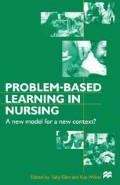Abstract
Pausing to consider what problem-based and distance learning have in common, it is tempting to argue that both play a role in liberating the learner. While PBL empowers the student to discover information for her- or himself, and to value that which is on offer through experience, distance learning makes education possible, even if a teacher is not close to hand (Rowntree, 1986). Both problem-based and distance learning claim to be student centred and facilitate the student in becoming a critical and independent thinker (Barrows and Tamblyn, 1980; Evans and Nation, 1989). Beyond this, however, there are significant difficulties in bringing the two educational approaches together. That which is assumed to be pivotal within PBL (for example, a facilitative tutor who has sustained and non-directive contact with students; Little and Ryan, 1988; Creedy and Hand, 1994) is not usually practical within distance learning. Distance learning, with its emphasis upon delivering a multitude of information in an accessible manner, seems the antithesis of learning by discovery. In short, PBL would seem to emphasise education as a process, while distance learning, by choice or necessity, is often portrayed as a product-driven system of learning.
Preview
Unable to display preview. Download preview PDF.
References
Barrows, H (1985) How To Design a Problem-based Learning Curriculum for the Pre-clinical Years, New York: Springer.
Barrows, H (1996) Problem-based Learning in Medicine and Beyond: A Brief Overview, New Directions for Teaching and Learning, 68: 3–12.
Barrows, H and Tamblyn, R (1980) Problem-based Learning: An Approach to Medical Education, New York: Springer.
Biley, F and Smith, K (1998) ‘The Buck Stops Here’: Accepting Responsibility for Learning and Actions after Graduation from a Problem-based Learning Nursing Education Curriculum, Journal of Advanced Nursing, 27(5): 1021–9.
Bradshaw, A. (1998) Defining ‘Competency’ in Nursing, Part II: An Analytic Review, Journal of Clinical Nursing, 7 (2): 103–11.
Brookfield, S (1987) Developing Critical Thinkers: Challenging Adults To Explore Alternative Ways of Thinking and Acting, Milton Keynes: Open University Press.
Carper, B (1978) Fundamental Patterns of Knowing in Nursing, Advances in Nursing Science, 1 (1): 13–23.
Clarke, B and James, C (1994) The Evaluation of Flexible Modes of Learning in Nurse Education and Practice, Conference Paper, Nurse Education Tomorrow Conference, September, University of Durham.
Conway, J (1996) Nursing Expertise and Advanced Practice, Dinton: Quay Books.
Creedy, D and Hand, B (1994) The Implementation of Problem-based Learning: Changing Pedagogy In Nurse Education, Journal of Advanced Nursing 20 (4): 696–702.
Doring, A, Bramwell-Vial, A and Bingham, B (1995) Staff Comfort/Discomfort with Problem-based Learning: A Preliminary Study, Nurse Education Today 15 (3): 263–6.
Elstein, A and Bordage, G (1988) Psychology of Clinical Reasoning. In Dowie, J and Elstein, A (eds), Professional Judgement: A Reader in Clinical Decision Making, Cambridge: Cambridge University Press.
Eraut, M (1990) Identifying the Knowledge which Underpins Performance. In Black, H (ed.) Knowledge and Competencies: Current Issues in Training and Education, London: Scottish Council for Research in Education, and Alison Wolffe, University of London.
Evans, T and Nation, D (1989) Critical Reflections on Distance Education, London: Falmar Press.
Jones, S and Brown, L (1991) Critical Thinking: Impact on Nursing Education, Journal of Advanced Nursing, 16 (5): 529–33.
Koch, T (1995) Interpretative Approaches in Nursing Research: The Influence of Husserl and Heidegger, Journal of Advanced Nursing, 21 (5): 827–36.
Lanoe, N and Price, B (1997) Education Applied to Practice: A Study Guide. London: RCN Institute.
Little, P and Ryan, G (1988) Educational Change through Problem-based Learning, Australian Journal of Advanced Nursing, 5 (4): 31–7.
Manley, K and McCormack, B (1998) Exploring Expert Practice: A Study Guide. London: The RCN Institute.
Morgan, C and Morris, G (1994) The Student View of Tutorial Support: Report of a Survey of Open University Education Students, Open Learning, 9 (1): 22–33.
Murphy, M (1995) Open Learning: The Manager’s and Education- alist Perspective, Journal of Advanced Nursing, 21 (5): 1016–23.
National Health Service Executive (1998) Integrating Theory and Practice in Nursing, Report Commissioned by the Chief Nursing Officer/Director of Nursing, London: DoH.
Parker, J and Wiltshire, J (1995) The Handover: Three Modes of Nursing Practice Knowledge. In Gray, G and Pratt, R (eds), Scholarship in the Discipline of Nursing, Melbourne: Churchill Livingstone, pp. 151–68.
Price, B (1997) Defining Quality Student Feedback in Distance Learning, Journal of Advanced Nursing, 26 (1): 154–60.
Price, B (1998) Theorising in Practice, Part 1 of Bellman, L. and Price, B (eds), Exploring the Art and Science of Nursing II: A Study Guide, London: RCN Institute.
Price, B (1999) Updating the Theory—practice Debate: An Occasional Paper. London: RCN Institute (Clarifying Theory for Practice–distance learning module).
Rangachari, P (1996) Twenty-up: Problem-based Learning with a Large Group. New Directions for Teaching and Learning, 68: 63–71.
Rowntree, D (1986) Teaching through Self Instruction: How To Develop Open Learning Materials, London: Kogan Page.
Spouse, J (1998) Scaffolding Student Learning in Clinical Practice, Nurse Education Today, 18 (4): 259–66.
Editor information
Editors and Affiliations
Copyright information
© 2000 Bob Price
About this chapter
Cite this chapter
Price, B. (2000). Introducing Problem-based Learning into Distance Learning. In: Glen, S., Wilkie, K. (eds) Problem-based Learning in Nursing. Nurse Education in Practice. Palgrave, London. https://doi.org/10.1007/978-0-333-98240-2_7
Download citation
DOI: https://doi.org/10.1007/978-0-333-98240-2_7
Publisher Name: Palgrave, London
Print ISBN: 978-0-333-77014-6
Online ISBN: 978-0-333-98240-2
eBook Packages: MedicineMedicine (R0)

